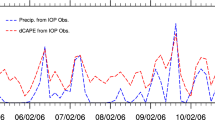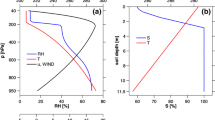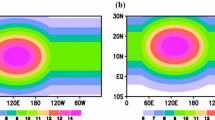Abstract
Despite recent advances in supercomputing, current general circulation models poorly represent the variability associated with organized tropical convection. In a recent study, the authors have shown, in the context of a paradigm two baroclinic mode system, that a stochastic multicloud convective parameterization based on three cloud types (congestus, deep and stratiform) can be used to improve the variability and the dynamical structure of tropical convection. Here, the stochastic multicloud model is modified with a lag type stratiform closure and augmented with an explicit mechanism for congestus detrainment moistening. These modifications improve the representation of intermittent coherent structures such as synoptic and mesoscale convective systems. Moreover, the new stratiform-lag closure allows for increased robustness of the coherent features of the model with respect to the amount of stochastic noise and leading to a multi-scale organization of slowly moving waves envelopes in which short-lived and chaotic convective events persist. Congestus cloud decks dominate the suppressed-dry phase of the wave envelopes. The simulations with the new closure have a higher amount of stochastic noise and result in a Walker type circulation with realistic mean and coherent variability which surpasses results of previous deterministic and stochastic multicloud models in the same parameter regime. Further, deterministic mean field limit equations (DMFLE) for the stochastic multicloud model are considered. Aside from providing a link to the deterministic multicloud parameterization, the DMFLE allow a judicious way of determining the amount of deterministic and stochastic “chaos” in the system. It is shown that with the old stratiform heating closure, the stochastic process accounts for most of the chaotic behavior. The simulations with the new stratiform heating closure exhibit a mixture of stochastic and deterministic chaos. The highly chaotic dynamics in the simulations with congestus detrainment mechanism is due to the strongly nonlinear and numerically stiff deterministic dynamics. In the latter two cases, the DMFLE can be viewed as a “standalone” parameterization, which is capable of capturing some dynamical features of the stochastic parameterization. Furthermore, it is shown that, in spatially extended simulations, the stochastic multicloud model can capture qualitatively two local statistical features of the observations: long and short auto-correlation times of moisture and precipitation, respectively and the approximate power-law in the probability density of precipitation event size for large precipitation events. The latter feature is not reproduced in the column simulations. This fact underscores the importance of gravity waves and large scale moisture convergence.











Similar content being viewed by others
References
Arakawa A, Schubert WH (1974) Interaction of a cumulus cloud ensemble with the large-scale environment, part I. J Atmos Sci 31:674–701
Betts AK, Miller MJ (1986) A new convective adjustment scheme. Part II: single column tests using GATE wave, BOMEX, ATEX and Arctic air-mass data sets. Q J R Meteorol Soc 112(473):693–709
Buizza R, Miller M, Palmer TN (1999) Stochastic representation of model uncertainties in the ECMWF ensemble prediction system. Q J R Meteorol Soc 125:2887–2908
ECMWF (2003) Proceedings ECMWF/CLIVAR workshop on simulation and prediction of intraseasonal variability with emphasis on the MJO, pp 3–6
Frenkel Y, Majda AJ, Khouider B (2012) Using the stochastic multicloud model to improve tropical convective parameterization: a paradigm example. J Atmos Sci 69(3):1080–1105
Gillespie DT (1975) An exact method for numerically simulating the stochastic coalescence process in a cloud. J Atmos Sci 32:1977–1989
Gillespie DT (1977) Exact stochastic simulation of couple chemical reactions. J Phys Chem 81:2340–2361
Grabowski WW (2001) Coupling cloud processes with the large-scale dynamics using the cloud-resolving convection parameterization. J Atmos Sci 58(9):978–997
Grabowski WW (2004) An improved framework for superparameterization. J Atmos Sci 61(15):1940–1952
Grabowski WW, Smolarkiewicz PK (1999) CRCP: a cloud resolving convection parameterization for modeling the tropical convecting atmosphere. Phys D Nonlinear Phenom 133:171–178
Han Y, Khouider B (2010) Convectively coupled waves in a sheared environment. J Atmos Sci 67:2913–2942
Hendon HH, Liebmann B (1994) Organization of convection within the Madden–Julian oscillation. J Geophys Res 99:8073–8084
Hohenegger C, Stevens B (2012) Preconditioning deep convection with cumulus congestus. J Atmos Sci. doi:10.1175/JAS-D-12-089.1
Holloway CE, Neelin JD (2009) Moisture vertical structure, column water vapor, and tropical deep convection. J Atmos Sci 66:1665
Holloway CE, Neelin JD (2010) Temporal relations of column water vapor and tropical precipitation. J Atmos Sci 67:1091–1105
Horenko I (2011) Nonstationarity in multifactor models of discrete jump processes, memory and application to cloud modeling. J Atmos Sci 68:1493–1506
Johnson RH, Rickenbach TM, Rutledge SA, Ciesielski PE, Schubert WH (1999) Trimodal characteristics of tropical convection. J Clim 12(8):2397–2418
Kain JS, Fritsch JM (1990) A one-dimensional entraining/detraining plume model and its application in convective parameterization. J Atmos Sci 47:2784–2802
Katsoulakis MA, Majda AJ, Vlachos DG (2003a) Coarse-grained stochastic processes for microscopic lattice systems. Proc Natl Acad Sci USA 100(3):782–787
Katsoulakis MA, Majda AJ, Vlachos DG (2003b) Coarse-grained stochastic processes and monte carlo simulations in lattice systems. J Comput Phys 186(1):250–278
Khouider B, Majda AJ (2005a) A non oscillatory balanced scheme for an idealized tropical climate model; part I: algorithm and validation. Theor Comput Fluid Dyn 19:331–354
Khouider B, Majda AJ (2005b) A non oscillatory balanced scheme for an idealized tropical climate model; part II: nonlinear coupling and moisture effects. Theor Comput Fluid Dyn 19:355–375
Khouider B, Majda AJ (2006a) Multicloud convective parametrizations with crude vertical structure. Theor Comp Fluid Dyn 20:351–375
Khouider B, Majda AJ (2006b) Multicloud convective parametrizations with crude vertical structure. Theor Comp Fluid Dyn 20:351–375
Khouider B, Majda AJ (2007) A simple multicloud parametrization for convectively coupled tropical waves. Part II: nonlinear simulations. J Atmos Sci 64:381–400
Khouider B, Majda AJ (2008a) Equatorial convectively coupled waves in a simple multicloud model. J Atmos Sci 65:3376–3397
Khouider B, Majda AJ (2008b) Multicloud models for organized tropical convection: enhanced congestus heating. J Atmos Sci 65:897–914
Khouider B, Majda AJ, Katsoulakis MA (2003) Coarse-grained stochastic models for tropical convection and climate. Proc Natl Acad Sci 100:11941–11946
Khouider B, Biello J, Majda AJ (2010a) A stochastic multicloud model for tropical convection. Commun Math Sci 8(1):187–216
Khouider B, St-Cyr A, Majda AJ, Tribbia J (2010b) MJO and convectively coupled waves in a coarse resolution GCM with a simple multicloud parametrization. J Atmos Sci 68:240–264
Kuang Z, Bretherton CS (2006) A mass-flux scheme view of a high-resolution simulation of a transition from shallow to deep cumulus convection. J Atmos Sci 63:1895–1909. doi:10.1175/JAS3723.1
Kuo HL (1974) Further studies of the parameterization of the influence of cumulus convection on large-scale flow. J Atmos Sci 31:1232–1240
Lau WKM, Waliser DE (2005) Intraseasonal variability in the atmosphere–ocean climate system. Springer, Berlin
Lin J, Neelin JD (2003) Toward stochastic deep convective parameterization in general circulation models. Geophys Res Lett 30(4):1162
Lin JL, Kiladis GN, Mapes BE, Weickmann KM, Sperber KR, Lin W, Wheeler MC, Schubert SD, Del Genio A, Donner LJ, Emori S, Gueremy JF, Hourdin F, Rasch PJ, Roeckner E, Scinocca JF (2006) Tropical intraseasonal variability in 14 IPCC AR4 climate models. Part I: convective signals. J Clim 19(12):2665–2690
Lintner BR, Holloway CE, Neelin JD (2011) Column water vapor statistics and their relationship to deep convection, vertical and horizontal circulation, and moisture structure at Nauru. J Clim 24:5454–5466
Majda AJ (2007) Multiscale models with moisture and systematic strategies for superparameterization. J Atmos Sci 64(7):2726–2734
Majda AJ, Khouider B (2002) Stochastic and mesoscopic models for tropical convection. Proc Natl Acad Sci 99:1123–1128
Majda AJ, Stechmann S, Khouider B (2007) Madden–Julian Oscillation analog and intraseasonal variability in a multicloud model above the equator. Proc Natl Acad Sci 104:9919–9924
Majda AJ, Franzke C, Khouider B (2008) An applied mathematics perspective on stochastic modelling for climate. Philos Trans R Soc A Math Phys Eng Sci 366(1875):2427–2453
Majda AJ, Stechmann SN (2008) Stochastic models for convective momentum transport. Proc Natl Acad Sci 105(46):17614–17619
Manabe S, Smagorinsky J, Strickler RF (1965) Simulated climatology of a general circulation model with a hydrologic cycle1. Mon Weather Rev 93(12):769–798
Mapes BE (2000) Convective inhibition, subgrid-scale triggering energy, and stratiform instability in a toy tropical wave model. J Atmos Sci 57(10):1515–1535
Mapes B, Tulich S, Lin J, Zuidema P (2006) The mesoscale convection life cycle: building block or prototype for large-scale tropical waves? Dyn Atmos Ocean 42:3–29
Moncrieff MW, Klinker E (1997) Organized convective systems in the tropical western Pacific as a process in general circulation models: a TOGA COARE case-study. Q J R Meteorol Soc 123:805–827
Moncrieff M, Shapiro M, Slingo J, Molteni F (2007) Collaborative research at the intersection of weather and climate. WMO Bull 56:204–211
Nakazawa T (1974) Tropical super clusters within intraseasonal variation over the western pacific. J Meteorol Soc Jpn 66:823–839
Neelin JD, Peters O, Lin JWB, Hales K, Holloway CE (2008) Rethinking convective quasi-equilibrium: observational constraints for stochastic convective schemes in climate models. Phil Trans R Soc A 366:2579–2602
Palmer TN (2001) A nonlinear dynamical perspective on model error: a proposal for non-local stochastic-dynamic parametrization in weather and climate prediction models. Q J R Meteorol Soc 127:279–304
Peters O, Neelin JD (2009) Atmospheric convection as a continuous phase transition: further evidence. Int J Mod Phys B 23:5453–5465
Peters O, Neelin JD, Nesbitt S (2009) Mesoscale convective systems and critical clusters. AGU Spring Meeting Abstracts, p. A5
Peters O, Deluca A, Corral A, Neelin JD, Holloway CE (2010) Universality of rain event size distributions. J Stat Mech Theory Exp 11:30
Randall D, Khairoutdinov M, Arakawa A, Grabowski W (2003) Breaking the cloud parameterization deadlock. Bull Am Meteorol Soc 84(11):1547–1564
Rapp AD, Kummerow CD, Fowler L (2011) Interactions between warm rain clouds and atmospheric preconditioning for deep convection in the tropics. J Geophys Res 116:D23210. doi:10.1029/2011JD016143
Scinocca JF, McFarlane NA (2004) The variability of modeled tropical precipitation. J Atmos Sci 61:1993–2015
Slawinska J, Pauluis O, Majda A, Grabowski W (2013) Multi-scale interactions in an idealized walker circulation: mean circulation and intra-seasonal variability. J Atmos Sci (submitted)
Slingo JM, Sperber KR, Boyle JS, Ceron J, Dix M, Dugas B, Ebisuzaki W, Fyfe J, Gregory D, Gueremy J, Hack J, Harzallah A, Inness P, Kitoh A, Lau W, McAvaney B, Madden R, Matthews A, Palmer TN, Parkas C, Randall D, Renno N (1996) Intraseasonal oscillations in 15 atmospheric general circulation models: results from an AMIP diagnostic subproject. Clim Dyn 12:325–357
Stechmann SN, Majda AJ (2009) Gravity waves in shear and implications for organized convection. J Atmos Sci 66:2579–2599
Stechmann SN, Neelin JD (2011) A stochastic model for the transition to strong convection. J Atmos Sci 68:2955–2970
Takayabu YN (1994) Large-scale cloud disturbances associated with equatorial waves. Part I: spectral features of the cloud disturbances. J Meteorol Soc Jpn 72:433–448
Takemi T, Hirayama O, Liu CH (2004) Factors responsible for the vertical development of tropical oceanic cumulus convection. Geophys Res Lett 31:L11109. doi:10.1029/2004GL020225
Tulich S, Mapes B (2008) Multi-scale convective wave disturbances in the tropics: insights from a two-dimensional cloud-resolving model. J Atmos Sci 65(1):140–155
Waite ML, Khouider B (2010) The deepening of tropical convection by congestus preconditioning. J Atmos Sci 67:2601–2615. doi: 10.1175/2010JAS3357.1
Wheeler M, Kiladis GN (1999) Convectively coupled equatorial waves: analysis of clouds and temperature in the wavenumber–frequency domain. J Atmos Sci 56(3):374–399
Wu CM, Stevens B, Arakawa A (2009) What controls the transition from shallow to deep convection? J Atmos Sci 66:1793–1806. doi:10.1175/2008JAS2945.1
Xing Y, Majda AJ, Grabowski WW (2009) New efficient sparse space time algorithms for superparameterization on mesoscales. Mon Weather Rev 137(12):4307–4324
Zhang C (2005) Madden–Julian oscillation. Rev Geophys 43:RG2003
Zhang GJ, McFarlane NA (1995) Sensitivity of climate simulations to the parameterization of cumulus convection in the Canadian Climate Centre General Circulation Model. Atmos Ocean 33:406–446
Acknowledgments
The research of B.K. is supported in part by the Natural Sciences and Engineering Research Council of Canada. The research of A.J.M. is partially supported by National Science Foundation grants DMS-0456713 and DMS-1025468 and by the office of Naval Research grants ONR DRI N0014-10-1-0554 and N00014-11-1-0306. Y.F. is a postdoctoral fellow supported through A.J.M.s above NSF and ONR grants.
Author information
Authors and Affiliations
Corresponding author
Appendix: Derivation of approximations for congestus and deep heating
Appendix: Derivation of approximations for congestus and deep heating
Here derive approximations for congestus and deep heating. We begin by considering a regime where the dependency of the cloud fractions on CAPE (and low level CAPE) is suppressed.
In this scenario, the cloud fraction transition rates are determined by fluctuations in dryness alone. This is accomplished by replacing CAPE and low level CAPE dependency in the transition rates by the RCE value of CAPE.
The hats are used to distinguish the modified rates used here for the purpose of comparison from the actual transition rates listed in Table 2. Here, \(\bar{C}\) is the RCE value of scaled CAPE, and scaled low level CAPE, in (19) and (18), respectively. The two quantities are equal at RCE. As before, D is the scaled dryness of the troposphere (20).
First, we consider the congestus heating equation for, the stochastic multicloud model.
At this point, we can take a derivative of the above expression to obtain
We assume that variations in CAPE l are small relative to the amount of CAPE l , as it would be the case near equilibrium. This allows us to concentrate on the first term of the expression above. Using (30), we write
With the simplified transition rates (36) and (37) and using the definitions of the rate R 10 from Table 2, we can rewrite Eq. 42 as
and from (40), we get
Furthermore, since σ c ≪ σ cs ≈ 1, we arrive at
In fact, we can rewrite the equation for the evolution of congestus heating in a simpler and more familiar form,
where
In order to derive equation for approximate deep convective heating. We consider Eq. 31 and make an assumption that the adjustment of deep convective cloud fraction is instantaneous. This yields approximation equation for the deep convective cloud fraction
Using the simplified transition rates (37–39) and constant transition rate R 23 from Table 2, this approximation takes form:
Again, since σ c ≪ σ cs ≈ 1, we write the last expression as
Under the above simplifying assumptions, using (23), deep convective heating is given approximately by
Rights and permissions
About this article
Cite this article
Frenkel, Y., Majda, A.J. & Khouider, B. Stochastic and deterministic multicloud parameterizations for tropical convection. Clim Dyn 41, 1527–1551 (2013). https://doi.org/10.1007/s00382-013-1678-z
Received:
Accepted:
Published:
Issue Date:
DOI: https://doi.org/10.1007/s00382-013-1678-z




